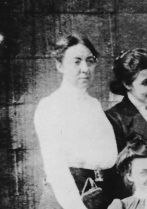It’s been interesting to me lately how often I get inspired by presentations to the DAR. I suppose I shouldn’t be surprised, since for the last two years I have been in charge of selecting the speakers, but whatever. In our most recent meeting, the speaker was discussing the history of the Cleveland Institute of Art. The CIA began in 1882 as the Western Reserve School of Design for Women (WRSDW).
 |
| Old City Hall, built in 1875. Source: Cleveland Memory Project. |
It was founded by Sarah Kimball, reportedly known as “Cleveland’s first militant suffragette,” in her own house on Euclid Avenue, intended to train women for a career in design–there was, after all, a shortage of marriageable men after the Civil War, and women had to do something to support themselves. The school was founded to teach “the principles of art and design as practically applied to artistic and industrial pursuits, and also the collection and exhibition of works of art and virtu.” (You can see a copy of the original Articles of Incorporation here.) In just six weeks, the school had outgrown Kimball’s house and moved to the attic of City Hall. Within one year, the school had grown to five instructors and 77 students.
 |
| Horace Kelley Mansion. Source: Cleveland Memory Project. |
The school was co-ed from its inception, but the name kept its focus on women until 1892. It was renamed the Cleveland School of Art and moved into the Horace Kelley Mansion on Willson Avenue, now known as East 55th Street. Efforts to merge the school with Adelbert College, now part of Case Western Reserve University, were unsuccessful, and the school remains independent to this day.
 |
| Cleveland School of Art. Source: Cleveland Memory Project. |
The School of Art remained in the Kelley Mansion until roughly 1906, when a new building was constructed in University Circle. In 1949, the school was renamed the Cleveland Institute of Art, and in 1956 moved around the corner into the more modern, and far less pretty, building in which it is still housed today.
In 2015, the Cleveland Institute of Art will move back onto Euclid Avenue into the former Model T Assembly plant that CIA acquired in 1981, and which now houses the Joseph McCullough Center for the Visual Arts.
 |
| Clara Wolcott Driscoll, c.1904-05. Source: Morse Museum of American Art. |
One of the WRSDW’s most notable alumna was Clara Wolcott Driscoll. Born in Tallmadge, Ohio, in 1861, Clara was a graduate of one of WRSDW’s first classes. In 1888, she moved to New York and found a job with the Tiffany Glass Company. Although she resigned in 1889 when she married Francis Driscoll–Tiffany did not employ married women–she returned to the company in 1892 when her husband died. She oversaw a small Women’s Glass Cutting Department. Tiffany was a proponent of women in his industry, because, Tiffany noted in 1894, women “were better suited than men for small hand work and possessed ‘natural decorative taste’ and ‘keen perception of color.’”
But in addition to glass cutting, Clara was a designer as well. In 2005, many of her letters came to light, revealing the fact that Tiffany did not design many of the lamps for which he was famous; Clara did.
 |
| Tiffany Studios Dragonfly Table Lamp, c. 1900-06. New York Historical Society |
Sources for more information on the Cleveland Institute of Art and Clara Driscoll:
“Cleveland Institute of Art,” Encyclopedia of Cleveland History
Cleveland Institute of Art website, http://www.cia.edu/about-us/history
“Designing Women in the Cleveland School of Art,” Marianne Berger Woods
“Breaking Tiffany’s Glass Ceiling: Clara Wolcott Driscoll (1861-1944),” CIA website, January 1, 2012
“Out of Tiffany’s Shadow, a Woman of Light,” New York Times, February 25, 2007
“A New Light on Tiffany: Clara Driscoll and the Tiffany Girls,” New York Historical Society traveling exhibit
“Tiffany Studio Designers,” Morse Museum of American Art exhibit
Website of Susan Vreeland, author of Clara and Mr. Tiffany (2012), http://www.svreeland.com/tiff.html
